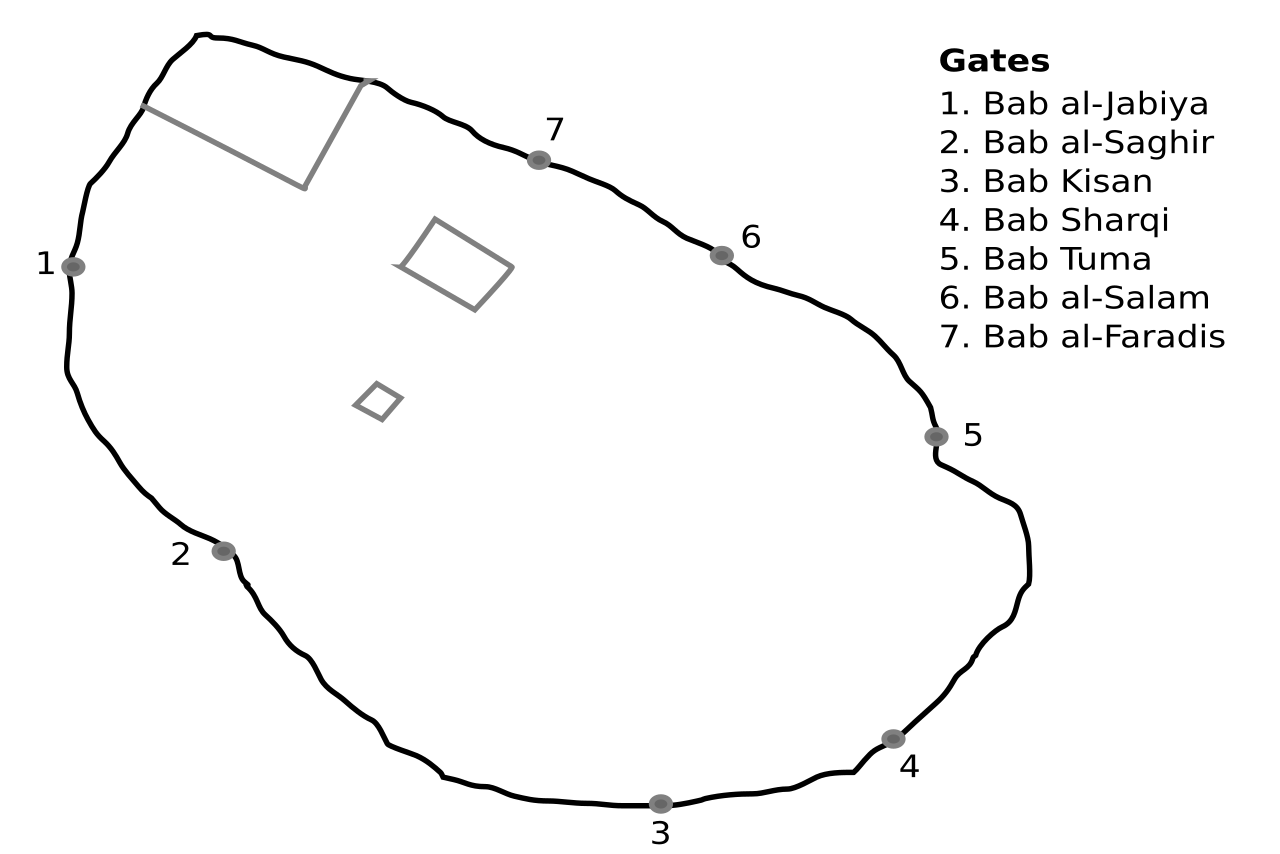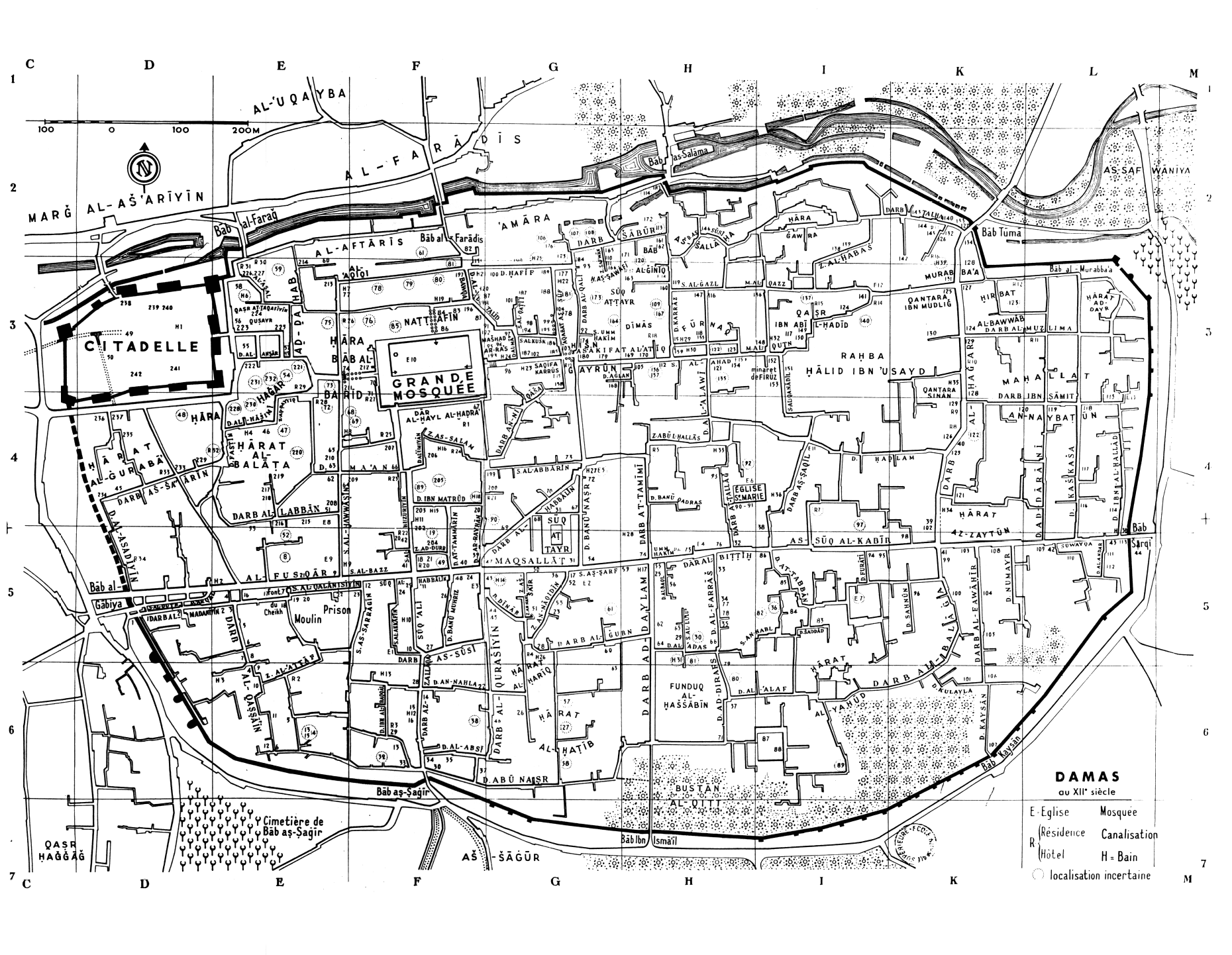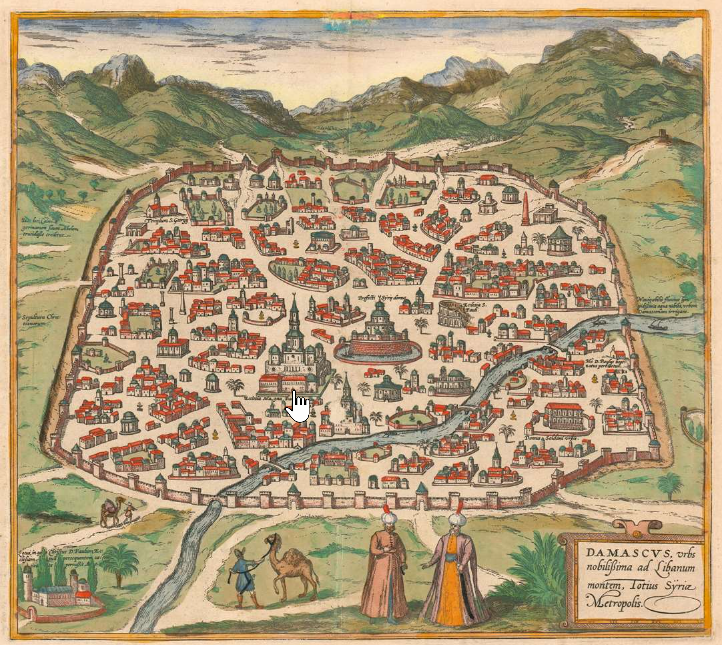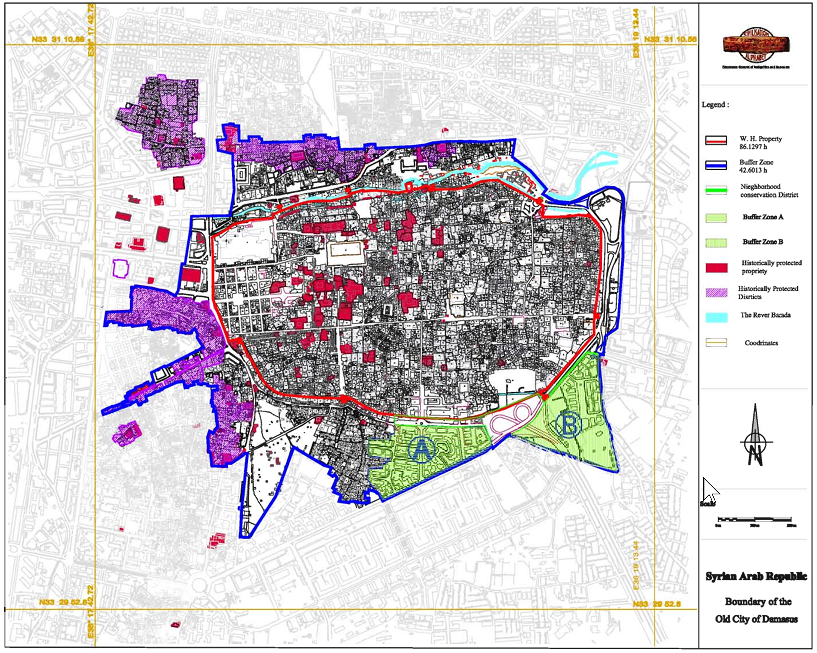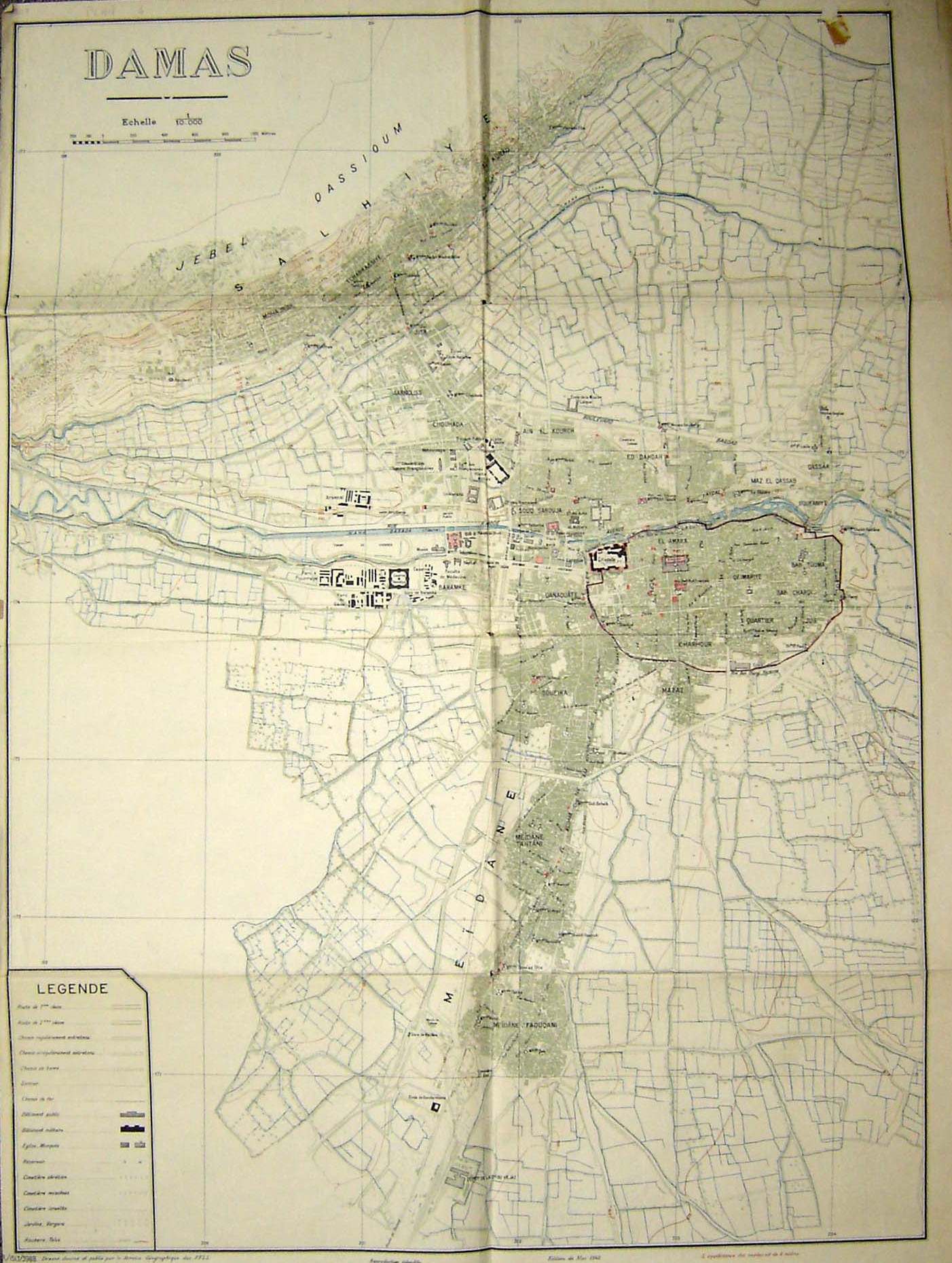Damascus

 Views of the Great (Umayyad) Mosque of Damascus from the air and from the ground
Views of the Great (Umayyad) Mosque of Damascus from the air and from the groundClick on either photo to open a high res magnifiable image in a new tab
Ground View from Bernard Gagnon - Wikipedia - CC BY-SA 3.0
| Transliterated Name | Language | Name |
|---|---|---|
| Damascus | English | |
| Damascus | Latin | Damascus |
| Damascus | Ancient Greek | Δαμασκός |
| Dimašq | Modern Arabic | دمشق |
| aš-Šām | Local Arabic colloquialism | الشَّام |
| Madīnat al-Yāsmīn | Arabic | ܕمَدِينَةُ الْيَاسْمِينِ |
| Darmswq | Classical Syriac | ܕܰܪܡܣܘܩ |
| Dammaśq | Old Aramaic | דמשק |
| Dammeśeq | Biblical Hebrew | דַּמֶּשֶׂק |
| Damask | Modern Hebrew | דמשק |
| T-m-ś-q | Ancient Egyptian (15th century BCE) | |
| Imerišú | Akkadian | |
| Dimasqa | Amarna letters - Akkadian | |
| Dimàsqì | Amarna letters - Akkadian | |
| Dimàsqa | Amarna letters - Akkadian |
Damascus resides in a basin east of the Anti-Lebanon range, at the foot of Mt. Qasiyun. Despite low annual rainfall, the plain is well watered by the Barada River allowing Damascus to exist as an oasis. Damascus has one of the longest periods of occupation (perhaps the longest period of occupation) of any city in the world. Due to its high urban density, very little excavation has been possible in Damascus (Stern et al, 1993). In 661 CE, the Umayyad Caliphate moved the capital to Damascus where it remained until 744 CE when Caliph Marwan II moved the capital to Harran. It was during the Umayyad period that the the Great Mosque of Damascus was built on the site of a Christian Basilica dedicated to John the Baptist. Construction was completed in 715 CE. When the Abbasid Caliphate supplanted the Umayyad Caliphate in 750 CE, the capital of the Caliphate moved to Baghdad.
- Fig. 1.8 Plan of early
Islamic Damascus from Whitcomb (2016)
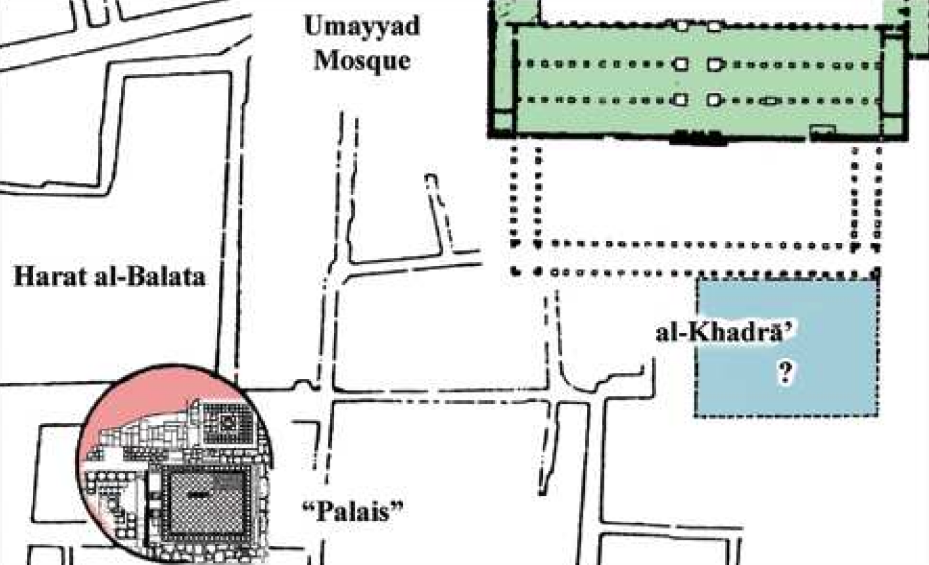
 Figure 1.8
Figure 1.8
Plan of early Islamic Damascus
(details after Saliby, “Un palais byzantino-omeyyade à Damas,” and Flood, Great Mosque of Damascus)
Whitcomb (2016) - Old City of Damascus
and its 7 gates from Whitcomb (2016)
- Sauvaget’s reconstructed
plan of “ancient/medieval Damascus" from Sauvaget (1949)
- 1575 Braun and Hogenberg
View / Map of Damascus from geographicus.com
- Boundaries of the Old City of Damascus from UNESCO
- Map of Damascus
from UNESCO
- Fig. 1.8 Plan of early
Islamic Damascus from Whitcomb (2016)

 Figure 1.8
Figure 1.8
Plan of early Islamic Damascus
(details after Saliby, “Un palais byzantino-omeyyade à Damas,” and Flood, Great Mosque of Damascus)
Whitcomb (2016) - Old City of Damascus
and its 7 gates from Whitcomb (2016)
- Sauvaget’s reconstructed
plan of “ancient/medieval Damascus" from Sauvaget (1949)
- 1575 Braun and Hogenberg
View / Map of Damascus from geographicus.com
- Boundaries of the Old City of Damascus from UNESCO
- Map of Damascus
from UNESCO
| Effect | Location | Image(s) | Description |
|---|---|---|---|
|
Damascus |
|
| Effect | Location | Image(s) | Description |
|---|---|---|---|
|
Damascus |
|
| Effect | Location | Image(s) | Description |
|---|---|---|---|
|
Damascus |
|
| Effect | Location | Image(s) | Description |
|---|---|---|---|
|
Damascus |
|
| Effect | Location | Image(s) | Description |
|---|---|---|---|
|
Damascus |
|
| Effect | Location | Image(s) | Description |
|---|---|---|---|
|
Damascus |
|
| Effect | Location | Image(s) | Description |
|---|---|---|---|
|
Damascus |
|
| Effect | Location | Image(s) | Description |
|---|---|---|---|
|
Damascus |
|
| Effect | Location | Image(s) | Description |
|---|---|---|---|
|
Damascus |
|
| Effect | Location | Image(s) | Description |
|---|---|---|---|
|
Damascus |
|
| Effect | Location | Image(s) | Description |
|---|---|---|---|
|
Damascus |
|
| Effect | Location | Image(s) | Description |
|---|---|---|---|
|
Damascus |
|
| Effect | Location | Image(s) | Description |
|---|---|---|---|
|
Damascus |
|
| Effect | Location | Image(s) | Description |
|---|---|---|---|
|
Damascus |
|
| Effect | Location | Image(s) | Description |
|---|---|---|---|
|
Damascus |
|
| Effect | Location | Image(s) | Description |
|---|---|---|---|
|
Damascus |
|
-
Earthquake Archeological Effects chart
of Rodríguez-Pascua et al (2013: 221-224)

 Earthquake Archeological Effects (EAE)
Earthquake Archeological Effects (EAE)
Rodríguez-Pascua et al (2013: 221-224)
| Effect | Location | Image(s) | Description | Intensity |
|---|---|---|---|---|
|
Damascus |
|
|
-
Earthquake Archeological Effects chart
of Rodríguez-Pascua et al (2013: 221-224)

 Earthquake Archeological Effects (EAE)
Earthquake Archeological Effects (EAE)
Rodríguez-Pascua et al (2013: 221-224)
| Effect | Location | Image(s) | Description | Intensity |
|---|---|---|---|---|
|
Damascus |
|
|
-
Earthquake Archeological Effects chart
of Rodríguez-Pascua et al (2013: 221-224)

 Earthquake Archeological Effects (EAE)
Earthquake Archeological Effects (EAE)
Rodríguez-Pascua et al (2013: 221-224)
| Effect | Location | Image(s) | Description | Intensity |
|---|---|---|---|---|
|
Damascus |
|
|
- Subjective MMI Intensity Scale
| Effect | Location | Image(s) | Description | Intensity |
|---|---|---|---|---|
|
Damascus |
|
|
- Subjective MMI Intensity Scale
| Effect | Location | Image(s) | Description | Intensity |
|---|---|---|---|---|
|
Damascus |
|
|
- Subjective MMI Intensity Scale
| Effect | Location | Image(s) | Description | Intensity |
|---|---|---|---|---|
|
Damascus |
|
|
- Subjective MMI Intensity Scale
| Effect | Location | Image(s) | Description | Intensity |
|---|---|---|---|---|
|
Damascus |
|
|
- Subjective MMI Intensity Scale
| Effect | Location | Image(s) | Description | Intensity |
|---|---|---|---|---|
|
Damascus |
|
|
-
Earthquake Archeological Effects chart
of Rodríguez-Pascua et al (2013: 221-224)

 Earthquake Archeological Effects (EAE)
Earthquake Archeological Effects (EAE)
Rodríguez-Pascua et al (2013: 221-224)
| Effect | Location | Image(s) | Description | Intensity |
|---|---|---|---|---|
|
Damascus |
|
|
-
Earthquake Archeological Effects chart
of Rodríguez-Pascua et al (2013: 221-224)

 Earthquake Archeological Effects (EAE)
Earthquake Archeological Effects (EAE)
Rodríguez-Pascua et al (2013: 221-224)
| Effect | Location | Image(s) | Description | Intensity |
|---|---|---|---|---|
|
Damascus |
|
|
-
Earthquake Archeological Effects chart
of Rodríguez-Pascua et al (2013: 221-224)

 Earthquake Archeological Effects (EAE)
Earthquake Archeological Effects (EAE)
Rodríguez-Pascua et al (2013: 221-224)
| Effect | Location | Image(s) | Description | Intensity |
|---|---|---|---|---|
|
Damascus |
|
|
-
Earthquake Archeological Effects chart
of Rodríguez-Pascua et al (2013: 221-224)

 Earthquake Archeological Effects (EAE)
Earthquake Archeological Effects (EAE)
Rodríguez-Pascua et al (2013: 221-224)
| Effect | Location | Image(s) | Description | Intensity |
|---|---|---|---|---|
|
Damascus |
|
|
-
Earthquake Archeological Effects chart
of Rodríguez-Pascua et al (2013: 221-224)

 Earthquake Archeological Effects (EAE)
Earthquake Archeological Effects (EAE)
Rodríguez-Pascua et al (2013: 221-224)
| Effect | Location | Image(s) | Description | Intensity |
|---|---|---|---|---|
|
Damascus |
|
|
-
Earthquake Archeological Effects chart
of Rodríguez-Pascua et al (2013: 221-224)

 Earthquake Archeological Effects (EAE)
Earthquake Archeological Effects (EAE)
Rodríguez-Pascua et al (2013: 221-224) - Subjective MMI Intensity Scale
| Effect | Location | Image(s) | Description | Intensity |
|---|---|---|---|---|
|
Damascus |
|
|
- Earthquake Archeological Effects chart
of Rodríguez-Pascua et al (2013: 221-224)
- Subjective MMI Intensity Scale
- Environmental Effects (ESI 2007)
- Synoptic Table of ESI 2007
Intensity Degrees from Michetti et al. (2007)

 Plate I
Plate I
Synoptic Table of ESI 2007 Intensity Degrees - The accuracy of the assessment improves in the higher degrees of the scale, in particular in the range of occurrence of primary effects, typically starting from intensity VIII, and with growing resolution for intensity IX, X, XI and XII. Hence, in the yellow group of intensity degrees (XI-XII) they become the most effective tool for intensity assessment.
click on image to open a higher resolution version in a new tab
Michetti et al. (2007)
| Effect | Location | Image(s) | Description | Intensity |
|---|---|---|---|---|
|
Damascus |
|
|
- Earthquake Archeological Effects chart
of Rodríguez-Pascua et al (2013: 221-224)
- Subjective MMI Intensity Scale
- Environmental Effects (ESI 2007)
- Synoptic Table of ESI 2007
Intensity Degrees from Michetti et al. (2007)

 Plate I
Plate I
Synoptic Table of ESI 2007 Intensity Degrees - The accuracy of the assessment improves in the higher degrees of the scale, in particular in the range of occurrence of primary effects, typically starting from intensity VIII, and with growing resolution for intensity IX, X, XI and XII. Hence, in the yellow group of intensity degrees (XI-XII) they become the most effective tool for intensity assessment.
click on image to open a higher resolution version in a new tab
Michetti et al. (2007)
| Effect | Location | Image(s) | Description | Intensity |
|---|---|---|---|---|
|
Damascus |
|
|
Allen, Terry (1999), Ayyubid Architecture, Occidental: Solipsist Press, ISBN 0-944940-02-1.
ADORNI, Elisa, Giampiero VENTURELLI, Mortars and Stones of the Damascus Citadel
(Syria), in: International Journal of Architectural
Heritage 4 (2010), pp. 337-350
Berthier, Sophie (2006), "La Citadelle de Damas: les apports d'une étude archéologique",
in Kennedy, Hugh (ed.), Muslim Military Architecture in Greater Syria: From the Coming of Islam to the Ottoman Period, History of Warfare (in French),
35, Leiden: Brill, pp. 151–164, ISBN 90-04-14713-6.
BESSAC, Jean-Clauce, Marianne BOQVIST, Les chantiers de construction de la
citadelle de Damas : méthodologie et résultats préliminaires,
in: Arqueología de la Arquitectura 4 (2005), pp. 237-249
Burns, Ross (2005), Damascus: A History, Milton Park: Routledge, ISBN 0-415-27105-3.
Charette, François (2003), Mathematical instrumentation in fourteenth-century Egypt and Syria: the illustrated treatise of Najm al-Dīn al-Mīṣrī, BRILL, ISBN 978-90-04-13015-9
Chevedden, Paul (1986), The Citadel of Damascus, Ann Arbor: U.M.I. Dissertation Information Service, OCLC 640193186
Gabrieli, Francesco (1984), Arab Historians of the Crusades, Berkeley: University of California Press, ISBN 978-0-520-05224-6
Dumper, Michael; Stanley, Bruce E. (2007). Cities of the Middle East and North Africa: A Historical Encyclopedia. ABC-CLIO. ISBN 1-57607-919-8.
Finkel, Caroline (2005), Osman's dream: the story of the Ottoman Empire, 1300-1923, Basic Books, ISBN 0-465-02396-7.
Flood, Finbarr Barry (2001). The Great Mosque of Damascus: studies on the makings of an Umayyad visual culture. Boston: BRILL. ISBN 90-04-11638-9.
Flood, Finbarr Barry (1997). "Umayyad Survivals and Mamluk Revivals: Qalawunid Architecture and the Great Mosque of Damascus". Muqarnas. Boston: BRILL. 14: 57–79. doi:10.2307/1523236.
HARTMANN-VIRNICH, Andreas (2005) Regards sur un grand chantier ayyoubide :
les
portes de la citadelle de Damas. L’apport de l’étude archéologique des
elevations, in: Arqueología de la Arquitectura 4
(2005), pp. 217-236
HARTMANN-VIRNICH, Andreas Les portes de la citadelle de Damas. La
contribution de l’archéologie du bâti à l’histoire cachée d’un monument,
in: Bulletin d’Études Orientales 61 (2012), pp. 41-66
Hitti, Phillip K. (October 2002). History of Syria: Including Lebanon and Palestine. Piscataway, NJ: Gorgias Press LLC. ISBN 978-1-931956-60-4.
Christof Galli (2001), "Middle Eastern Libraries", International Dictionary of Library Histories, Chicago: Fitzroy Dearborn Publishers, ISBN 1579582443, 1579582443
Hillenbrand, Carole (2000), The Crusades: Islamic Perspectives, New York: Routledge, ISBN 978-0-415-92914-1.
Ibn Khaldūn; Fischel, Walter Joseph (1952). Ibn Khaldūn and Tamerlane:
their historic meeting in Damascus, 1401 a.d. (803 a. h.) A study based on Arabic manuscripts of Ibn Khaldūn's "Autobiography". University of California Press.
Kleiner, Fred. Gardner's Art through the Ages, Vol. I Cengage Learning, 2013. p. 264
Le Strange, Guy (1890), Palestine Under the Moslems: A Description of Syria and the Holy Land from A.D. 650 to 1500, Committee of the Palestine Exploration Fund (Ibn Jubayr: p.240 ff)
Qummi, Shaykh Abbas (2005). Nafasul Mahmoom. Qum: Ansariyan Publications. p. 362.
Ibn Ṣaṣrā, Muḥammad ibn Muḥammad (1963). William M. Brinner (ed.). A chronicle of Damascus, 1389-1397
American architect and architecture, 1894, p.58.
Sauvaget, Jean (1930) La
citadelle de Damas, in: Syria 11 (1930), pp. 59-90,
216-241
Tafseer Ibn Katheer, vol.9, p.163, published in Egypt. Tafseer Durre Manthur Vol.6, p.30-31.
Takeo Kamiya (2004). "Umayyad Mosque in Damascus, Syria". Eurasia News. Retrieved 31 December 2015.
Rosenwein, Barbara H. A short history of the Middle Ages. University of Toronto Press, 2014. p. 56
Walker, Bethany J. (Mar 2004). "Commemorating the Sacred Spaces of the Past: The
Mamluks and the Umayyad Mosque at Damascus". Near Eastern Archaeology. The American Schools of Oriental Research. 67 (1): 26–39. doi:10.2307/4149989.
M. Lesley Wilkins (1994), "Islamic Libraries to 1920", Encyclopedia of library history, New York: Garland Pub., ISBN 0824057872, 0824057872
Wolff, Richard (2007), The Popular Encyclopedia of World Religions: A User-Friendly Guide to Their Beliefs, History, and Impact on Our World Today, Harvest House Publishers, ISBN 0-7369-2007-2
Whitcomb, D. (2016) “Notes for an archaeology of Muʿāwiya: material culture in the transitional period of believers.”
In A. Borrut and F. M. Donner, eds. Christians and Others in the Umayyad State.(2016).United States:Oriental Institute of the University of Chicago.
Winter, Michael; Levanoni, Amalia (2004). The Mamluks in Egyptian and Syrian politics and society. BRILL. ISBN 90-04-13286-4.
Yamen Dabbour, Yamen (2012) À la découverte de la braie et du fossé autour de l’enceinte de Damas,
in: Bulletin d’Études Orientales 61 (2012), pp. 23-40
OldDamascus.com
LoveDamascus.com
Citadel of Damascus at madainproject.com
Umayyad Mosque in Damascus at madainproject.com
Umayyad Mosque Profile Archived 2010-11-20 at the Wayback Machine. Archnet Digitial Library.
Great Mosque of Damascus - Encyclopaedia Britannica.
Wellhausen (1927:382-383) relates that in the summer of 746 CE (A.H. 128) during the 3rd Muslim Civil War, Marwan II ordered the walls of Hims, Jerusalem, Baalbek, Damascus, and other prominent Syrian cities razed to the ground. In Theophanes entry for A.M.a 6237, we can read in Mango and Scott (1997:587)'s translation (Turtledove's translation is available here):
[A.M. 6237, AD 744/5]...
- Constantine, 5th year
- Marouam, 2nd year
- Zacharias, 12th year
- Anastasios, 16th year
- Theophylaktos, 2nd year
At that time Marouam, after victoriously taking Emesa [aka Homs], killed all the relatives and freedmen of Isam. He also demolished the walls of Helioupolish [aka Baalbek] Damascus, and Jerusalem, put to death many powerful men, and maimed those remaining in the said cities.

